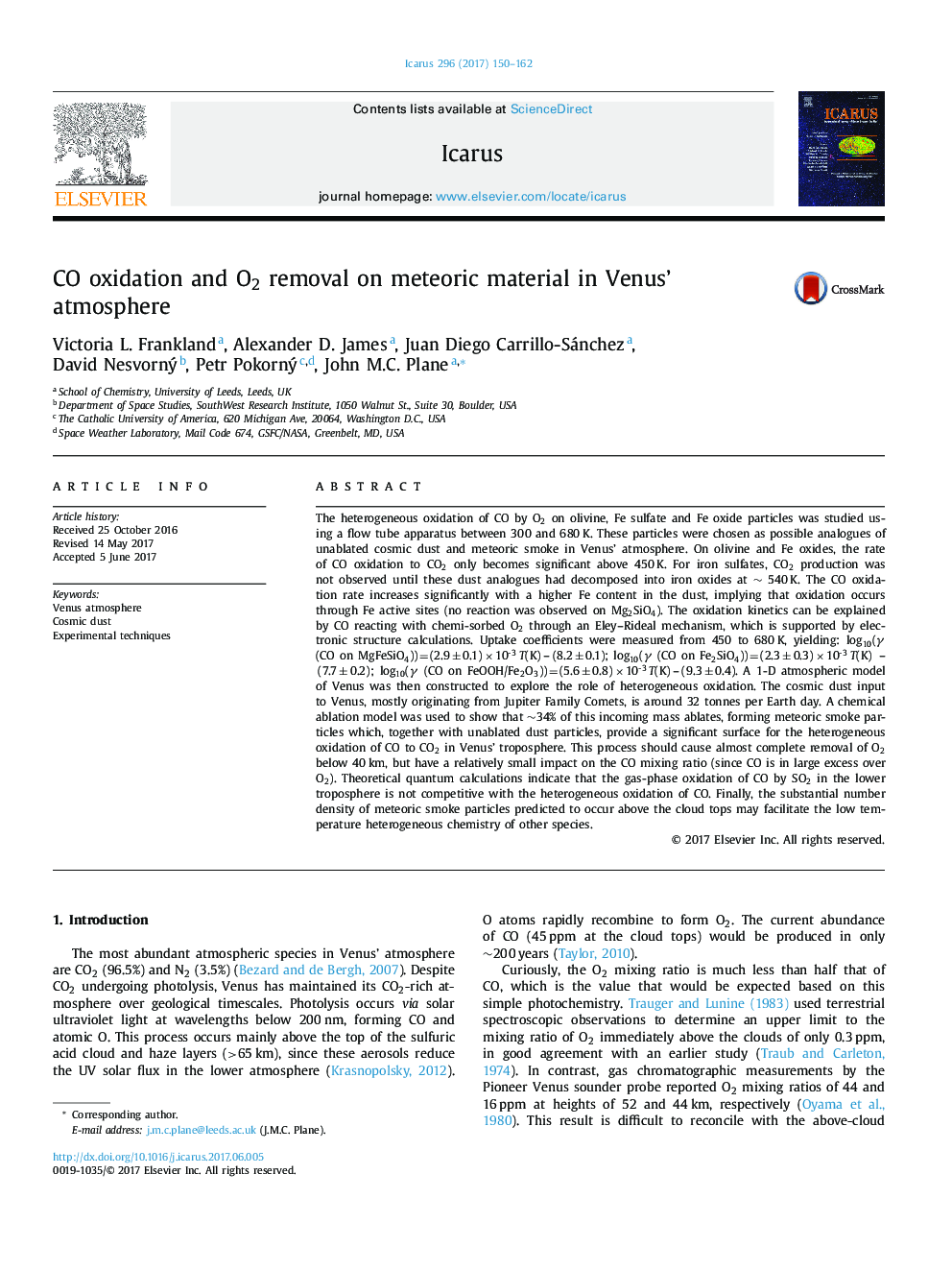| کد مقاله | کد نشریه | سال انتشار | مقاله انگلیسی | نسخه تمام متن |
|---|---|---|---|---|
| 5486977 | 1523495 | 2017 | 13 صفحه PDF | دانلود رایگان |
عنوان انگلیسی مقاله ISI
CO oxidation and O2 removal on meteoric material in Venus' atmosphere
دانلود مقاله + سفارش ترجمه
دانلود مقاله ISI انگلیسی
رایگان برای ایرانیان
کلمات کلیدی
موضوعات مرتبط
مهندسی و علوم پایه
علوم زمین و سیارات
علوم فضا و نجوم
پیش نمایش صفحه اول مقاله

چکیده انگلیسی
The heterogeneous oxidation of CO by O2 on olivine, Fe sulfate and Fe oxide particles was studied using a flow tube apparatus between 300 and 680 K. These particles were chosen as possible analogues of unablated cosmic dust and meteoric smoke in Venus' atmosphere. On olivine and Fe oxides, the rate of CO oxidation to CO2 only becomes significant above 450 K. For iron sulfates, CO2 production was not observed until these dust analogues had decomposed into iron oxides at â¼ 540 K. The CO oxidation rate increases significantly with a higher Fe content in the dust, implying that oxidation occurs through Fe active sites (no reaction was observed on Mg2SiO4). The oxidation kinetics can be explained by CO reacting with chemi-sorbed O2 through an Eley-Rideal mechanism, which is supported by electronic structure calculations. Uptake coefficients were measured from 450 to 680 K, yielding: log10(γ (CO on MgFeSiO4)) = (2.9â±â0.1) Ãâ10-3 T(K) - (8.2â±â0.1); log10(γ (CO on Fe2SiO4)) = (2.3â±â0.3) Ãâ10-3 T(K) - (7.7â±â0.2); log10(γ (CO on FeOOH/Fe2O3)) = (5.6â±â0.8) Ãâ10-3 T(K) - (9.3â±â0.4). A 1-D atmospheric model of Venus was then constructed to explore the role of heterogeneous oxidation. The cosmic dust input to Venus, mostly originating from Jupiter Family Comets, is around 32 tonnes per Earth day. A chemical ablation model was used to show that â¼34% of this incoming mass ablates, forming meteoric smoke particles which, together with unablated dust particles, provide a significant surface for the heterogeneous oxidation of CO to CO2 in Venus' troposphere. This process should cause almost complete removal of O2 below 40 km, but have a relatively small impact on the CO mixing ratio (since CO is in large excess over O2). Theoretical quantum calculations indicate that the gas-phase oxidation of CO by SO2 in the lower troposphere is not competitive with the heterogeneous oxidation of CO. Finally, the substantial number density of meteoric smoke particles predicted to occur above the cloud tops may facilitate the low temperature heterogeneous chemistry of other species.
ناشر
Database: Elsevier - ScienceDirect (ساینس دایرکت)
Journal: Icarus - Volume 296, 1 November 2017, Pages 150-162
Journal: Icarus - Volume 296, 1 November 2017, Pages 150-162
نویسندگان
Victoria L. Frankland, Alexander D. James, Juan Diego Carrillo-Sánchez, David Nesvorný, Petr Pokorný, John M.C. Plane,